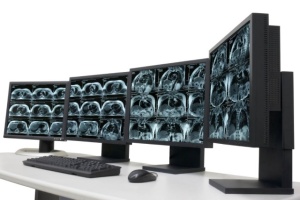Radiologists Think "Ergonomics" When it Comes to Furniture
by
Joan Trombetti, Writer | August 20, 2007

Ergonomic reading room
State-of-the-Art ergonomic adjustable furniture has allowed radiologists to perform in a more successful manner with less chance of injury and more comfort while performing their jobs. This helps to increase quality and productivity in an organization, as well as create higher employee satisfaction and lower workmen's compensation.
Because of the complexity of the field of radiology, there are fewer radiologists, making the workload particularly heavy and stressful. Ergonomic researchers have found that repetitive stress injuries along with tiredness can create problems unless departments are aware of the necessary environmental changes that could have a positive or negative impact on a radiologist's efficiency and effectiveness.
Reading rooms designed the ergonomic way with height-adjustable radiology reading room furniture for PACS and mammography are less stressful, more comfortable and offer a very productive work environment for physicians and assistants. This includes lighting, sound, overall room design and furniture.
Workstations are tailored to all sizes; however, any equipment that is designed for people of various sizes whose physical needs are not known or may change, should consult the National Ergonomic Standards for Height and Adjustment that provides for the 5th percentile (4'11" tall -- when seated) to the 95th percentile (6'3" -- when standing). It is also advised to determine compliance to BSR/HFES 100 Human Factors Engineering of Computer Workstations Standards. Other points to consider are the range of height adjustment, the monitor mounting system, hardware mounts, cable maintenance, ease of use, stability, functionality and climate controls, installation and service, air quality indoors, warranty and company reputation.
It is also advised when purchasing ergonomic height-adjustable furniture to check the following websites: The Human Factors and Ergonomics Society, (HFES) -- www.hfes.org and the American National Standards Institute (ANSI) -- www.ansi.org.
